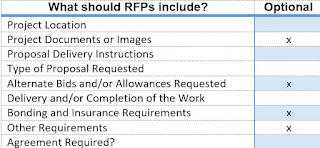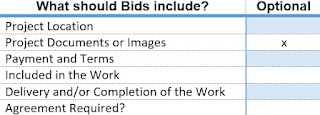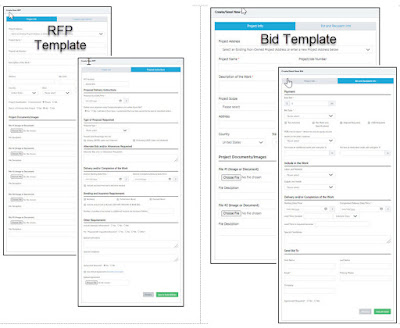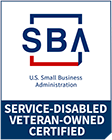Very powerful tools help prepare RFPs and Bids in minutes

Getting more than just a price! Because good RFPs give you the confidence and knowledge of knowing you will get a meaningful response(s) to your requests.
Here are four acronyms commonly used in the Construction Industry when seeking costs, pricing or solutions and where they are commonly used:

BAFO – Best and Final Offer – A request to one bidder/proposer or short-listed group of bidders/proposers for their best price(s) for a specific solicitation prior to determining a contract award.
RFI – Request for Information – This is usually used during the design or construction phase or during the RFP negotiating phrase primarily for clarification purposes.
RFP – Request for Proposal – A written request from the requestor (usually the owner or a contractor) to a contractor, design professional or subcontractor for an estimate or cost proposal. The RFP usually contains a specific scope of work.
RFQ – Request for Price Quote – Also known as an Invitation for Bid (IFB) is used for soliciting price quotes and bids for the chance to fulfill certain tasks for projects from selected suppliers and contractors.
WHEN ARE RFPS USED?
- Where the request requires professional expertise or a building construction specialty
- Where the product or service being requested is not currently included or under a contract
- When one requires research, development or a solution to create whatever is being requested.
WHAT DOES AN RFP DO?
- Informs potential bidders of a procurement opportunity.
- Alerts bidders that the selection process is competitive.
- Presents preliminary requirements for the bid being requested
- Allows for an open (wide distribution) or a closed (narrow) response
- Ensures that all bidders respond factually to the identified requirements
- Infers impartiality – that the bidding process is expected to follow a structured evaluation and selection procedure, a crucial factor in public works projects

PROJECT LOCATION – This is a description of where the project is located or the actual address.
PROJECT DOCUMENTS OR IMAGAGES – Any applicable documents such as drawings and specifications that cannot be covered in the Description of the Work and/or the Scope of Work.
PROPOSAL DELIVERY INSTRUCTIONS – Where, who, where and how to respond to the RFP
TYPE OF PROPOSAL REQUESTED – Options include Lump Sum, Time and Material, Not to Exceed, and Other
Provide unit percentage fees for; or Adding (MORE) labor and materials and deducting (LESS) labor and materials
In the event more or less labor or materials will be needed/not needed to complete your project it is good to know, in advance, how much you will be charged for such changes.
Unit percentage is the percentage rate the contractor will charge in addition to the actual cost of the labor and materials on added or deducted items. For example: The unit percentages have been established as 5% for more (additive) work and 2% for less (deductive) work. You have decided to remove (deduct) the carpet from the contract amount. The contractor will prepare a change order request to deduct the cost of the carpet including installation costs plus 2%. And if you were adding the carpet to the contract the contractor would prepare a change order proposal to add the cost of the carpet including installation costs plus 5%.
It is not uncommon for deductive (LESS) unit percentages to be 0% because some contractors feel that they have already spent time and energy on the item and therefore do not want to return any part of their markup on deductive items.
ALTERNATE BIDS OR ALLOWANCES – When budgets are tight it is not uncommon to request alternate prices or allowances for components, materials and/or equipment. And sometimes the contractor will submit a bid with his own proposed Alternates or Allowances.
Alternates are useful when you need to compare prices for certain items or if you want to see if specified items can be substituted with an item of equal or better qualities for a lesser price.
Allowances are useful when the component or item specified in unclear. In this case an allowance (cost allowance) for the bid item will be included in the proposal and ultimately the contract. When the actual substantiated cost of the component or item is obtained the following will occur: If the cost is less than the allowance amount the owner would receive a credit for the difference; but if the cost is more than the allowance the contractor would be paid the additional amount.
DELIVERY AND/OR COMPLETION OF THE WORK
Starting Date/Time – This is your desired project starting date and/or time
Completion Date/Time – This is your desired project completion date and/or time; OR
Delivery Date/Starting Time – This is primarily for items being delivered to your project such as materials or equipment.
Include any lead time items and time needed – It is not uncommon for contractors or vendors to need time to receive items or equipment. Some items need to be fabricated, are back ordered, or have shipping restrictions that take time. Therefore, it is important to know what items require lead time and how much time because this information allows you to make a decision on possibly substituting the item(s) with something else or simply deleting it from the contract documents or scope of work.
Include the number of calendar days to complete the work – Use this section if the schedule is based on the number of days instead of an actual completion date. “Calendar days” are consecutive days whereas “days” alone can be construed as meaning only “Working days.
BONDING AND INSURANCE REQUIREMENTS – If a bond is necessary for your project select type of bond Bid Bond, Performance Bond, Payment Bond
Number of Parties to be named as additional insured – This is the number of people and/or entities you want named as additional insured’s on the certificates or insurance for your project such as the construction lender, contractor, Home owner Association, etc. Usually parties involved in the project ask to be named as additional insured’s.
Tip!
Always demand certificates of insurance, with your limits of insurance, from the contractor before he/she starts the work and examine the coverage expiration dates and being satisfied with the amount of coverage the policies offer; otherwise, you may incur considerable liability.
Tip!
Limits of Insurance – These are the minimum insurance limits that you require for your project. Your insurance underwriter, most likely, would be pleased to provide you with these limits. Generally, all construction contracts will have a section on insurance stating the property owner’s and contractor’s insurance obligations under the contract. The worksheets in this system only include contractor’s Insurance requirements.
OTHER REQUIREMENTS:
Pre-Proposal Site Inspection – This is sometimes referred to as a “Pre-Bid Inspection” and as a rule, contractors insist on inspecting a project before submitting a cost proposal or bid because they want to familiarize themselves with the site to be satisfied that there are no existing conditions contrary to the RFP requirements and/or bidding documents. And most property owners would insist on having such an inspection. An example of a project not necessarily requiring a site inspection would be an emergency repair such as roof leaks or a faulty water heater repairs.
Inspection Date/Time – The is the date and time you want to hold the site inspection
Special Instructions – These are any special instructions or requirements for the site inspection.
Special Conditions – These are terms and conditions, which may be unique to small or home improvement projects. For larger and more complex projects Special Conditions are a part of the Contract Documents and usually take precedence over the Uniform General Conditions.
WHO TO SEND RFPS TO?
You can choose to send RFPs to a single bidder, multiple short-listed selected bidders, or to the public for anyone to bid. A Bid Opening can be open (where the bidders are permitted to attend) or closed (where the bidders are not permitted to attend).
Depending on the scope of the work it may be desirable to follow a detailed bidder screening process to short list the bidders who should be invited for further rounds of negotiation. Screening processes may include bidder scoring models or internal discussions within the proposed bid
BIDDING 101 
Here are the most common ways of bidding on projects:

WHEN ARE BIDS USED?
- Where the request requires professional expertise or a building construction specialty
- Where the product or service being requested is not currently included or under a contract
- When one requires research, development or a solution to create whatever is being requested.

PROJECT LOCATION
– This is a description of the where the project is located or the actual address.
PAYMENT AND TERMS:
Bid or Proposal Amount – The US Dollar amount proposed to successfully complete the work in accordance with the contract documents.
Deposit Required – Deposits usually equal the shipping costs of ordered items and do not include costs for labor and materials. Deposits should be reasonable.
Advance Required – Advance payment amounts for contracts are generally regulated by local or state contracting agencies. You can obtain these allowed advance amounts by contacting your respective local contractor’s licensing board.
Tip!
Don’t confuse an advance with a deposit. Deposits are generally for ordered items whereas an advance is an amount given to the contractor on the total contract amount. Don’t advance more than what is allowed by the local regulatory agencies which is usually a percentage of the contract amount.
COD Payments Required – When checked this means that COD payments are required.
FOB Job Site – When checked this means that the liability for the item(s) changes hands when they arrive and are accepted at the Job site.
FOB Installed – When checked this means that the liability for the item(s) changes hands upon completing and accepting the installation of the item.
FOB Factory – When checked this means that the liability for the item(s) changes hands upon leaving the respective manufacturing facility.
For more or additional work add cost plus (Percentage) – This is the unit percentage rate the contractor will charge in addition to the actual cost of the labor and materials on added (MORE) items.
For less or deductive work deduct cost plus (Percentage) – This is the unit percentage rate the contractor will charge in addition to the actual cost of the labor and materials on deducted (LESS) items.
INCLUDED IN THE WORK:
Labor and Materials – This means that the cost of labor and materials have been included in the total cost.
Labor Only – This means that only the cost for labor has been included in the total cost.
Materials Only – This means that only the cost of the materials have been included in the total cost
Supply and Install – This means that the cost to supply and install the item(s) have been included in the total cost
Install Only – This means that the cost to install a particular item(s) only have been included in the total cost
Supply Only – This means that only the cost to supply the particular item(s) have been included in the total cost
DELIVERY AND COMPLETION:
Starting Date/Time – This is the project starting date and/or time
Completion Date/Time – This is project completion date and/or time
Delivery Date/Starting Time – This is the delivery and/or installation starting time for items such as materials or equipment
Other – These are any other terms and conditions that may apply to the agreement.
Work will be completed within – Use this section if the schedule is based on the number of days instead of an actual completion date above. “Calendar days” are consecutive days whereas “days” alone can be construed as meaning only “working days”.
Lead Time Needed – This is the amount of lead time needed by the contractor or vendor for delivery of an item(s) or to begin the project.
Tip!
Adjust your scheduled completion time based on any lead-time requirements because this makes your schedule realistic and avoids conflicts.
QUALIFICATIONS OR EXCLUSIONS – Here is where you note anything to qualify your proposal such as clarifications; or if you are excluding any thing such as, but not necessarily limited to, items, components, activities, work, etc. from your proposal. If you have any doubts or performance concerns list them in this section. For Example: If the completion or delivery time of an item compromises the requested completion time as set forth in the bidding documents it may be necessary to qualify the proposal by saying “the completion time is subject to receiving the (item) from the manufacturer by (Date)”.
Very powerful tools help prepare RFPs and Bids in minutes
RFPs and Quick Bids Powered by Constructionplace.com
These affordable proprietary RFP and Quick Bid tools from Constructionplace.com, a self-help mobile website provider since 1999. Constructionplace.com leverages the power and intelligence of these mobile RFPs and Quick Bid templates with the best end-to-end RFP management service to increase the completion speed of your RFP process by more than 50%. Not to mention without the need for paper products and your ability to immediately recover needed time and resources to focus on project priorities.

References:
- Gary and Taemi Westernoff (2011) Construction like Sushi
- Gary Westernoff (1998) Construction Management Made Easy
- Constructionplace.com Glossary
- Constructionplace.com





